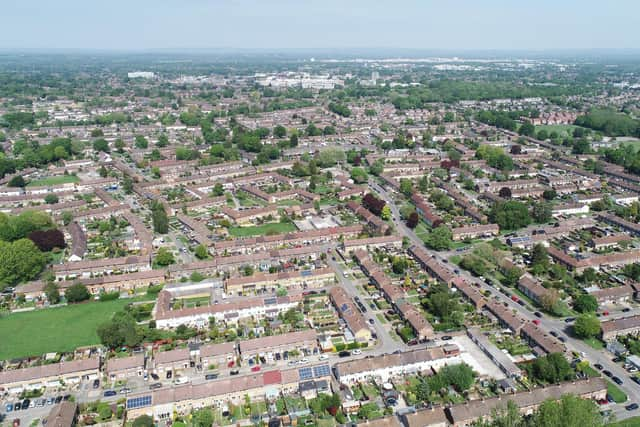Revealed: Where Crawley sits in the property market's most recession-proof strongholds, according to new research
and live on Freeview channel 276
Just one in eight residents of the London borough of Kensington and Chelsea has a mortgage on their home, meaning most will be unaffected by the spike in interest rates which the Financial Conduct Authority predicts could push 770,000 households into mortgage arrears over the next two years.
Garrington’s analysis shows that 27.6% of households in Kensington and Chelsea own their home outright, and that levels of outstanding mortgage debt in the wealthy borough are exceptionally low, at just 7.3% of the total value of homes there. Property in the borough – which includes two homes owned by Rishi Sunak – is the UK’s most expensive, with a median price of £1.4m in the year to June 2022, according to the Land Registry.
Advertisement
Hide AdAdvertisement
Hide AdAt the other end of the scale, almost a third (32.1%) of households in Crawley have a mortgage on their home and the total debt-to-equity ratio is three times higher than Kensington’s at 21.4%. This ranks Crawley 96th in the strongholds most resistant to price falls but ninth in the top 10 weak spots most likely to see prices fall. Croydon ranks fourth in the weak spots list.


First-time buyers – who typically have few savings to fall back on and are more exposed to interest rate rises as mortgage payments swallow up a big chunk of their earnings – account for 7.1% of households in Crawley. By contrast, they make up just 0.1% of Kensington & Chelsea residents.
Separate data from the Nationwide shows the average first-time buyer is already spending 39% of their take-home pay on a mortgage, close to the levels seen in the run up to the 2008 financial crisis. Areas with high numbers of first-time homeowners could see recent buyers forced into selling at a discount if they struggle to afford their mortgage when their interest rate rises.
By cross-referencing levels of mortgage debt, the proportion of first-time buyers and price movements over the past year, Garrington has ranked a representative sample of 96 areas across England and Wales according to their resilience to rising interest rates and the likely impact on property prices.
Advertisement
Hide AdAdvertisement
Hide AdBritain’s most unaffordable property market – the London borough of Westminster, where the average home costs 15.6 times the average resident’s salary4 – comes second in the ranking, with the historic university cities of Oxford, York, Cambridge and Exeter all making the top 10.
The bottom of the table is dominated by more affordable areas popular with first-time buyers, where homeowners have much higher levels of mortgage debt as a percentage of the value of their homes. First-time buyers account for one in 10 homeowners in Dartford in Kent, and 8% in 95th placed Milton Keynes. Many of these markets also saw very rapid price rises following the pandemic – average prices in Milton Keynes jumped by 17.4% in the year to the end of November 2022 – which may now increase the likelihood of a correction.
Jonathan Hopper, CEO of the buying agents Garrington Property Finders, comments: “The property market is going through a rapid transition, but the biggest falls seen so far have been in transactions rather than prices. The most recent Land Registry data shows average prices paid across by the UK fell by just 0.3% in November.
“Nevertheless, the ripple effects will intensify over the coming months as rising interest rates feed through into homeowners’ monthly mortgage payments. But our research indicates some markets will be affected much more than others.
Advertisement
Hide AdAdvertisement
Hide Ad“Prime London postcodes, as well as several popular university cities, are the most likely to escape relatively unscathed. Homeowners in these markets often have a good chunk of equity under their belts and are therefore more insulated from rising mortgage costs. Unlike much of the country, the three London boroughs in our ‘most resilient’ top 10 also saw prices fall last year, making them less prone to further correction now and thus an attractive proposition to buyers looking for stability.
“By contrast, our research suggests that towns which saw very rapid post-pandemic price rises and lots of first-time buyers, such as Crawley and Milton Keynes, could be set for sharper price falls in 2023. For tactical buyers looking to secure a big discount, these more exposed areas could throw up some strong buying opportunities this year.”